
Parlor, Colonel Robert J. Milligan House. Saratoga Springs, New York, 1854–56. Brooklyn Museum; Dick S. Ramsay Fund, 40.930

Parlor, Colonel Robert J. Milligan House. Saratoga Springs, New York, 1854–56. Brooklyn Museum; Dick S. Ramsay Fund, 40.930

George Jacob Hunzinger (American, born Germany, 1835–1898). Side Chair, Patented March 13, 1883. Wood, cane, straw braid, 353⁄8 x 171⁄2 x 203⁄8 in. (89.9 × 44.5 × 51.8 cm). Brooklyn Museum; Designated Purchase Fund, 2011.13
The inventor and designer George Hunzinger secured twenty-one furniture patents between 1860 and 1898, more than any other American manufacturer, for a wide array of folding chairs, tables, chaises, and novel structural innovations. He was both a prescient genius of abstract, spare design and a man of his times: the Japanese tatami matting on this chair illustrates the contemporary taste for exoticism.
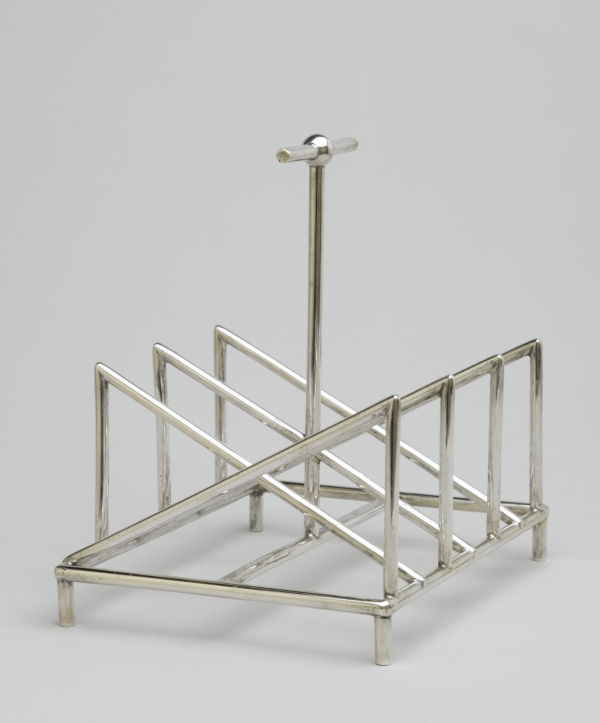
Christopher Dresser (English, 1834–1904). Toast Rack, circa 1880. Silver, 53⁄8 x 51⁄4 x 41⁄4 in. (13.7 × 13.3 × 10.8 cm). Manufactured by Tiffany & Company (New York, active 1853–present). Brooklyn Museum; Gift of Marie Bernice Bitzer, by exchange, 1997.114
This design was first made by James Dixon & Sons, in Sheffield, England, in the early 1880s. Dresser did freelance work for Tiffany & Company as a purchasing agent in Japan and as a metalware designer; this is the only known version of this toast rack with a Tiffany hallmark.

Attributed to Daniel Pabst (American, born Germany, 1826–1910). Side Chair, circa 1880, Philadelphia. Ebonized cherry, later upholstery, 371⁄8 x 213⁄4 x 19 in. (94.3 × 55.2 × 48.3 cm). Brooklyn Museum; Marie Bernice Bitzer Fund, 2002.11
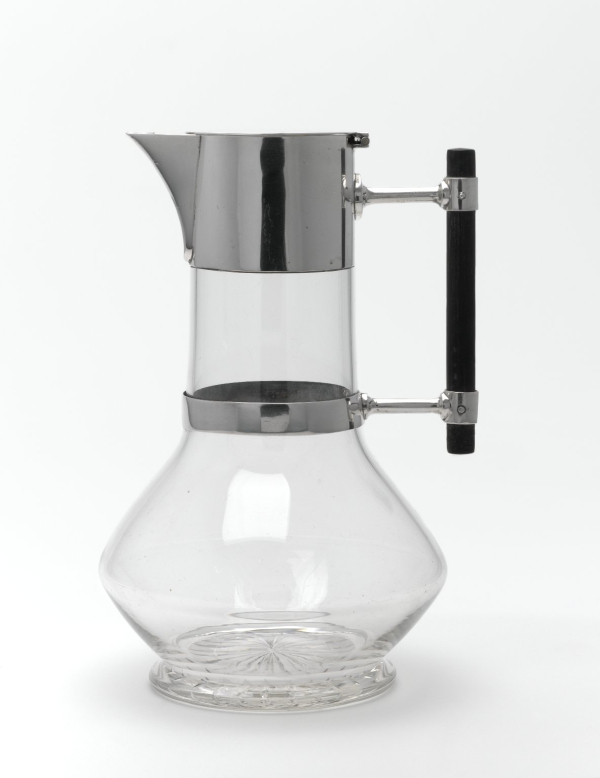
Christopher Dresser (English, 1834–1904). Decanter, designed 1881. Manufactured by Hukin & Heath (Birmingham, England, active 1878–87). Glass, silver, ebonized wood, 81⁄2 x 53⁄4 x 57⁄8 in. (21.6 × 14.6 × 14.9 cm). Brooklyn Museum; Gift of Paul F. Walter, 2007.10.3
Christopher Dresser, one of the foremost independent industrial designers of the nineteenth century, produced an amazing array of forward-looking designs in ceramic, metal, textile, wallpapers, carpets, and furniture as a freelancer for leading firms such as Wedgwood and Minton. He was trained as a botanist and searched for the underlying geometry in nature. He also hoped to realize the promise of the Industrial Revolution to make well-designed products available to as large an audience as possible, often using inexpensive materials.
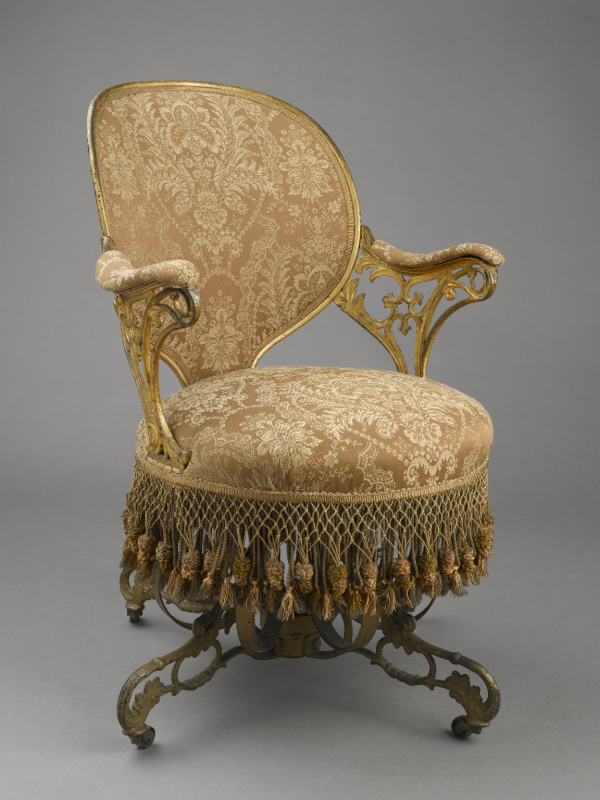
Thomas E. Warren (American, 1808–18?). “Centripetal Spring” Chair, patented September 25, 1849. Manufactured by the American Chair Company (active 1829–1858). Cast iron, sheet metal, wood, modern upholstery, original fringe, 341⁄4 x 231⁄2 x 281⁄4 in. (87 × 59.7 × 71.8 cm). Brooklyn Museum; Designated Purchase Fund, 2009.27
Thomas E. Warren’s “Centripetal Spring” chair is the forerunner of Don Chadwick and Bill Stumpf’s Aeron chair, designed nearly 150 years later. Both are made principally of metal, raised on casters for mobility, rotate on a central column, and allow for adjustment of the angle of the seat. Although Warren’s chair bears a patent mark (on the bottom of the seat), he felt the need to mitigate the newness of his invention by concealing its ingenious metal spring system beneath a dense, soft curtain of luxurious passementerie (elaborate trim). Similarly, he disguised his progressive use of cast iron for the frame by rendering it in the backward-looking Rococo Revival style and gilding it.
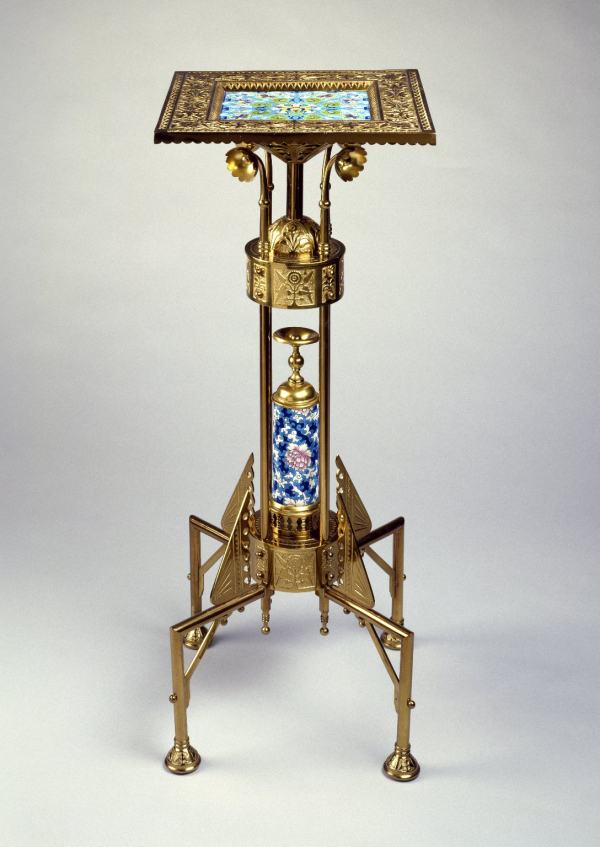
Bradley & Hubbard Manufacturing Company (active 1854–1940). Stand, circa 1885, Meriden, Connecticut. Brass, glazed earthenware, 3213⁄16 x 133⁄8 x 133⁄8 in. (83.3 × 34.0 × 34.0 cm). Brooklyn Museum; Gift of the American Art Council, 1998.45
This is a very early example of the use of bent tubular metal to make furniture, a technique more often associated with twentieth-century modernist design (particularly Marcel Breuer’s tubular steel furniture, produced by Thonet in the mid-1920s). Bradley & Hubbard were also pioneers of a progressive manufacturing technique known as the interchangeability of parts. Some of the decorative elements on this table were also used in their brass lighting devices. Casting a large number of the same parts at once and incorporating them into many different designs saved time and money and streamlined production. This innovative, wholly modern process foretold the manufacturing methods of the twentieth century.
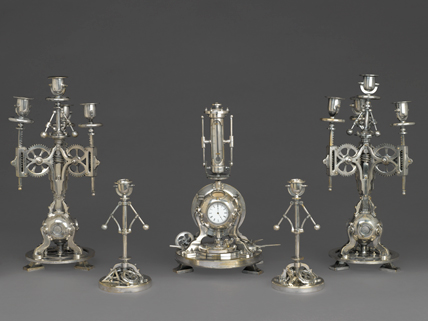
Guilmet Cie (active 1861–1910). Five-Piece Clock Garniture, circa 1885. Silvered bronze, 91⁄4 x 41⁄2 x 41⁄2 in. (23.5 × 11.4 × 11.4 cm). Brooklyn Museum; Gift of Marcus S. Friedlander, by exchange, 2009.49.1-5
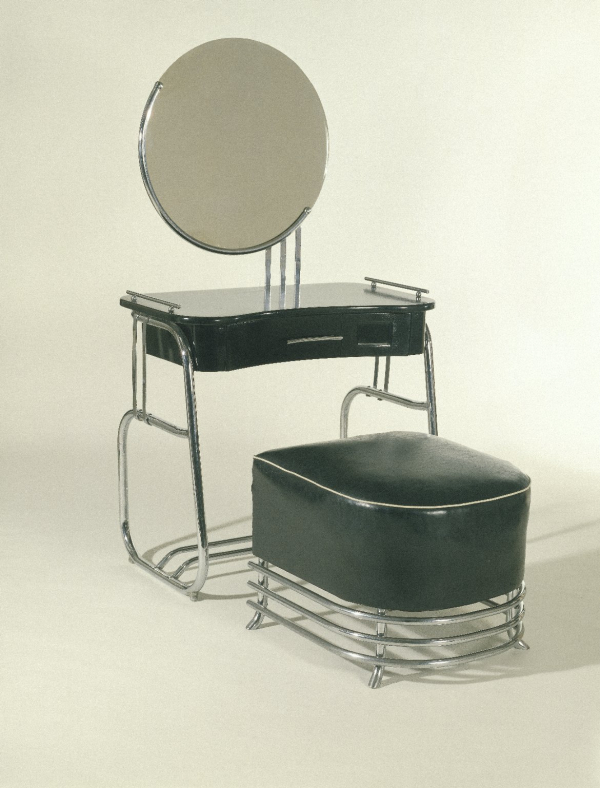
Vanity with Mirror and Stool. Kem Weber (American, born Germany, 1889–1963). Made by Lloyd Manufacturing Company. Menominee, Michigan, 1934. Chrome-plated tubular steel, wood, glass, upholstery, vanity: 55 × 33 × 191⁄2 in. (139.7 × 83.8 × 49.5 cm), stool: 171⁄2 x 21 × 221⁄2 in. (44.5 × 53.3 × 57.2 cm). Brooklyn Museum; Modernism Benefit Fund, 87.123.1a–b and 87.123.2

Bed. John Henry Belter (American, born Germany, 1804-1863). New York, circa 1856. Rosewood, 651⁄2 x 581⁄2 x 83 in. (166.4 × 148.6 × 210.8 cm). Brooklyn Museum; Gift of Mrs. Ernest Vietor, 39.30

Tray-Top Table. Attributed to Robert Harrold (American, born England, 18th century). Portsmouth, New Hampshire, circa 1770. Mahogany, mahogany veneer, 291⁄4 x 341⁄2 x 231⁄2 in. (74.3 × 87.6 × 59.7cm). Brooklyn Museum; Matthew Scott Sloan Collection, Gift of Lidie Lane Sloan McBurney, 1997.150.16
This is one of about a half-dozen known tables of this type made in Portsmouth in the late eighteenth century. Often called China tables, they were used for the important social ritual of tea drinking. The elegant and refined design is indebted to Thomas Chippendale, and a related table appears in his wIdely known pattern book. The design incorporates both Chinese influences (seen in the gallery around the top) and Gothic motifs (seen in the delicate arched stretchers).
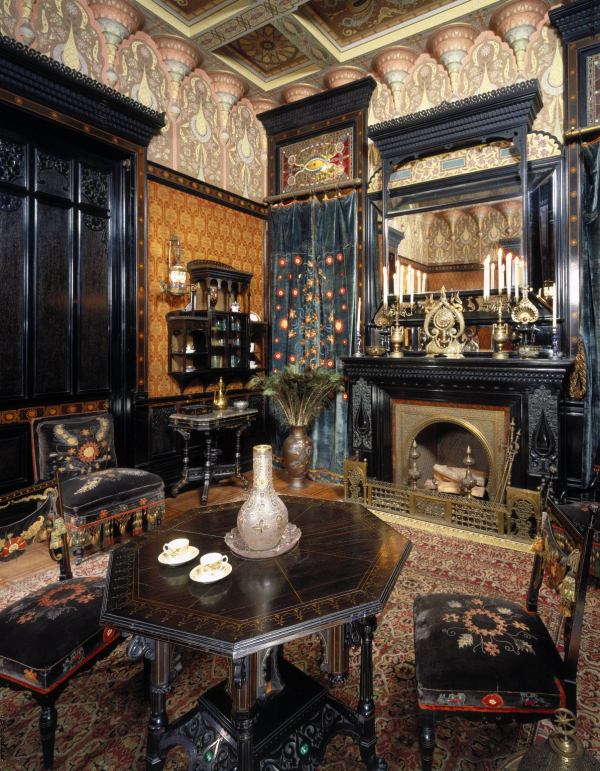
Moorish Smoking Room, The Worsham-Rockefeller House. New York, built circa 1864–65, remodeled circa 1881. Brooklyn Museum; Gift of John D. Rockefeller, Jr., and John D. Rockefeller III, 46.43
The John D. Rockefeller House was a brownstone built between 1864 and 1865 at 4 West 54th Street in New York City. Mr. Rockefeller purchased the house in 1884 from Arabella Worsham, who had recently enlarged and redecorated it. The house’s Moorish Smoking Room represents a new trend in American design in terms of both style and execution. Inspired by Asian and Near Eastern designs popular at the time, its style was considered appropriate for the function of the room—a retreat for gentlemen to use for smoking, a slightly exotic activity. The design is the work of a professional. The interior design profession had been born in the mid-1870s, when, for the first time, owners of houses placed the design of entire rooms in someone else’s hands. As a result, design became less focused on individual furnishings than on the overall appearance of the room.

Weil-Worgelt Study. Decorated by Alavoine of Paris and New York. Paris, circa 1928–30. Brooklyn Museum; Gift of Raymond Worgelt, 70.23
The Weil-Worgelt Study is the only twentieth-century period room on exhibition at the Brooklyn Museum. It was originally part of the Park Avenue apartment of Mr. and Mrs. Milton Weil. The decorating firm of Alavoine, of Paris and New York, supervised its creation, using a unified concept that designed all the room’s elements, including the paneling, the furnishings, and the accessories in the style now known as Art Deco. The room is paneled in veneers of palisander (Brazilian rosewood) and olive and incorporates a painted lacquered panel designed by Henri Redard and executed by Jean Dunand. In one corner, the interior of a closet opens to become a bar, and the bar itself slides out across the doorway. When the apartment was designed, the United States was in the midst of Prohibition, and building the bar into the closet provided a quick and easy way to conceal its function.
Period Rooms
Long-Term Installation
Decorative Arts and Design Galleries, 4th Floor
Our Period Rooms are closed to the public through June 2024. School groups can make appointments to visit the Jan Martense and Nicholas Schenck houses by contacting youth.tours@brooklynmuseum.org.
A highlight of our Decorative Arts and Design collection is a group of American period rooms ranging in date from the seventeenth century to the twentieth century. Interspersed with these rooms are galleries that display an outstanding collection of American and European decorative arts.
Additional objects from the Decorative Arts and Design collection are on view in our fourth-floor galleries and in the fifth-floor Luce Center for American Art, which includes the Visible Storage • Study Center.
